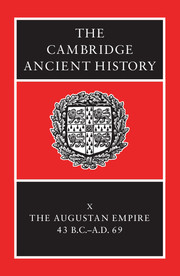10 - Provincial administration and taxation
from PART II - THE GOVERNMENT AND ADMINISTRATION OF THE EMPIRE
Published online by Cambridge University Press: 28 March 2008
Summary
ROME, THE EMPEROR AND THE PROVINCES
The reorganization of provincial government which began with Augustus' so-called first settlement in January 27 B.C. gave to the imperial administration in the provinces a fundamental structure which it was to retain for more than three centuries. Its basis can only be fully appreciated in the light of the developments of the late republican period. In the East the Roman organization of Greece and Asia had taken advantage of the urban legacy of hellenization and set the pattern of which the far-reaching arrangements of Pompey's eastern settlement were a logical extension. Here, the ubiquitous phenomenon of organization through the hellenized poleis, based on specific and definable relationships between the city and the ruling power, was to find its clearest expression, whilst the military and fiscal interests of Rome knitted diverse communities into a loose provincial structure. In the West, Spain, Africa and Narbonensis required a longer period of development and acclimatization to Roman rule, accelerating noticeably only in the last three or four decades of the first century B.C. and drawing in their wake the newly acquired regions of Gallia Comata. If East and West differed in pace of ‘Romanization’ and in many a significant detail, the broad objectives did not: the need to encourage or create civilized and self-sufficient communities (whether based on polis or civitas) governed by their indigenous aristocracies; the need to ensure Rome's military security and the protection of her imperial interests in the broad sense, the cost of which would be met (at the least) by the revenue which Rome could draw from the province enjoying her protection; finally, as a natural corollary, the need to support and promote the interests of Romans in the provinces, senators and equites at the top of the social and economic scale, then negotiatores, veteran colonists and increasing numbers of assimilated provincial Roman citizens.
Keywords
- Type
- Chapter
- Information
- The Cambridge Ancient History , pp. 344 - 370Publisher: Cambridge University PressPrint publication year: 1996
References
- 8
- Cited by



